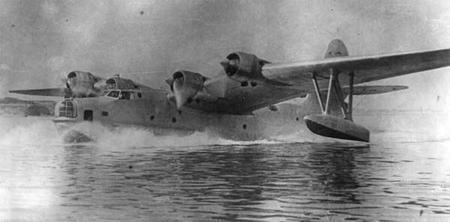Top speed 355 km/h Length 22 m | Wingspan 36 m | |
 | ||
The Tupolev MTB-2 (Russian: Морской Тяжелый Бомбардировщик — Heavy Naval Bomber), also known as the ANT-44, was a four-engine prototype flying boat designed in the Soviet Union in 1935.
Contents
Design and development
The ANT-44 was designed as a long-range maritime reconnaissance/bomber flying boat. Construction of the first two prototype began in 1934. The initial design employed an all-metal construction with a shoulder-mounted semi-gull wing. The ANT-44 incorporated four 604 kW (810 hp) Gnome-Rhône Mistral Major 14Kdrs M-85 radial engines as well as underslung stabilizing floats. After a month of factory trials, in December 1937 designers changed the Mistral Major radial engines for the higher rated and more powerful Tumansky M-87 627 kW (840 hp) engines. In 1938, they further modified the prototype to be amphibious, and the aircraft was refitted with updated 709 kW (950 hp) M-87A engines.
The second prototype, designated ANT-44bis or ANT-44D, was an amphibious aircraft powered by four M-87A engines. With I. M. Sukhomlin at the controls, the aircraft set several world records in its class:
Operational history
Only the two MTB-2 prototypes were built by Tupolev: the Soviet Union's entry into World War II interrupted any further development. Both aircraft were pressed into service in the Black Sea region. The ANT-44D, piloted by I. M. Sukhomlin, saw limited use in 1941–1943, both as a bomber and a transport, and performed other tasks, such as emergency supply flights.
Operators
Specifications (ANT-44D)
Data from
General characteristics
Performance
Armament
2 20mm ShVAK cannon, 4 7.62mm ShKAS machine guns, 2000kg-4000kg bombs (4400lb-8800lb)
